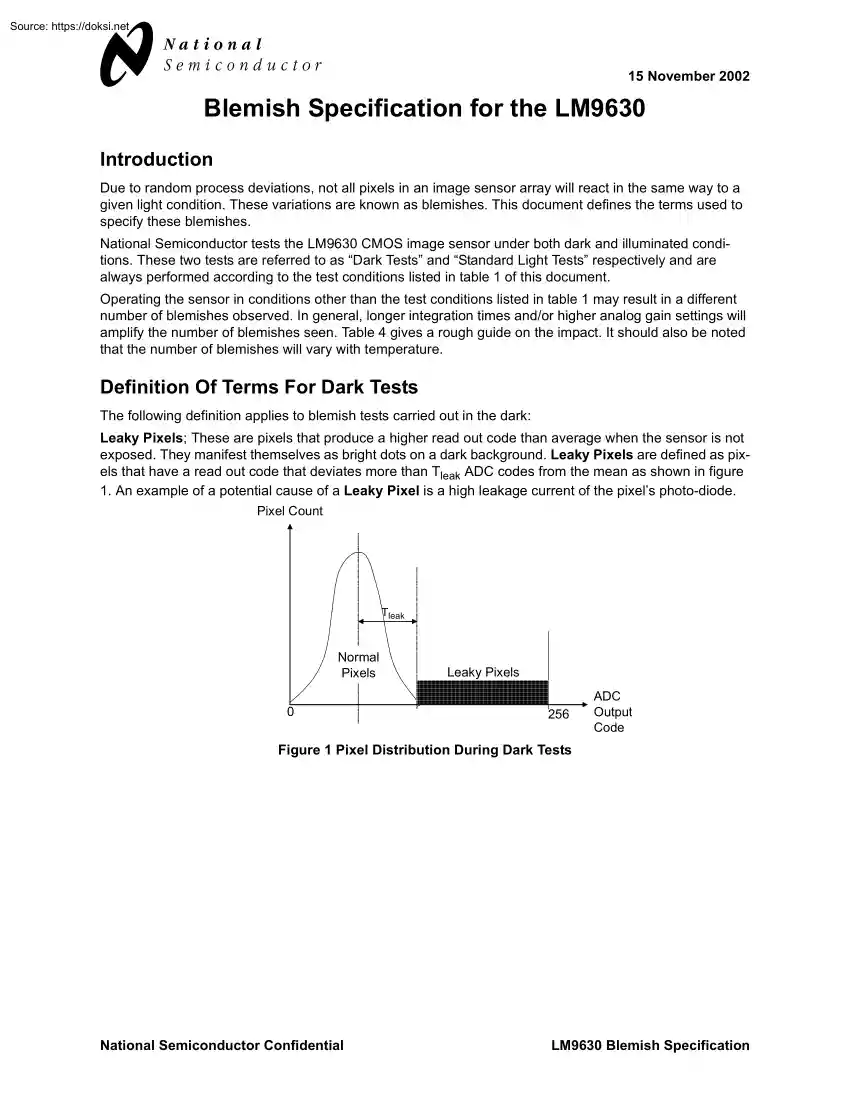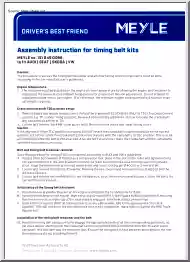A doksi online olvasásához kérlek jelentkezz be!

A doksi online olvasásához kérlek jelentkezz be!
Nincs még értékelés. Legyél Te az első!
Mit olvastak a többiek, ha ezzel végeztek?
Tartalmi kivonat
15 November 2002 Blemish Specification for the LM9630 Introduction Due to random process deviations, not all pixels in an image sensor array will react in the same way to a given light condition. These variations are known as blemishes This document defines the terms used to specify these blemishes. National Semiconductor tests the LM9630 CMOS image sensor under both dark and illuminated conditions. These two tests are referred to as “Dark Tests” and “Standard Light Tests” respectively and are always performed according to the test conditions listed in table 1 of this document. Operating the sensor in conditions other than the test conditions listed in table 1 may result in a different number of blemishes observed. In general, longer integration times and/or higher analog gain settings will amplify the number of blemishes seen. Table 4 gives a rough guide on the impact It should also be noted that the number of blemishes will vary with temperature. Definition Of Terms For
Dark Tests The following definition applies to blemish tests carried out in the dark: Leaky Pixels; These are pixels that produce a higher read out code than average when the sensor is not exposed. They manifest themselves as bright dots on a dark background Leaky Pixels are defined as pixels that have a read out code that deviates more than Tleak ADC codes from the mean as shown in figure 1. An example of a potential cause of a Leaky Pixel is a high leakage current of the pixel’s photo-diode Pixel Count Tleak Normal Pixels 0 Leaky Pixels 256 ADC Output Code Figure 1 Pixel Distribution During Dark Tests National Semiconductor Confidential LM9630 Blemish Specification 15 November 2002 Definition Of Terms For Standard Light Tests The following definitions apply to blemish tests carried out in standard light conditions: Standard Light; Illuminated blemish tests are performed under standard light conditions. The light level is chosen in such a manner that the pixels produce
relatively high output readings (e.g 70% of the saturation level). Cold Pixels; These are pixels that produce a lower read out code than average when the sensor is exposed to light. They manifest themselves as lower intensity dots when compared to a uniformly illuminated background These pixels can be detected by exposing the sensor to light, and detecting the pixels that deviate more than a percentage Tcold from the mean, as shown in figure 2. A example of a potential cause of a Cold Pixel is a dust particle on top of the pixel. Pixel Count Tcold% Cold Pixels Normal Pixels 256 0 ADC Output Code Figure 2 Pixel Distribution During Light Tests Other Definitions Defective Pixels; These are defined as pixels that are either Leaky or Cold. Total Number of Defective Pixels; This is the total count of Defective Pixels in a given array. Cluster Defects; Cluster defects are defined as two or more adjacent Defective Pixels on the same row.Active Area: All Blemish specifications are only
applied to pixels that fall into the 118 by 96 active window of the CMOS image sensor as shown in figure 3 All pixels outside this area are not tested r1,c128 r1,c1 r3,c6 r3,c123 r98,c6 r98,c123 r100,c128 r100,c1 r = row number c = column number = active area Figure 3 LM9630 Active Area National Semiconductor Confidential LM9630 Blemish Specification 15 November 2002 Test Conditions Blemish testing is performed under the following conditions: Parameter Condition Frame rate 100 frames/second full resolution Exposure time 80µs Black Level ADC Code 5 ADC reference voltage Internally Generated mclk 10MHz, 50:50 duty cycle Gain Setting 5X Other Register Settings REV Bit 7 = 1 Hex ; Bits (6:0) default MCFG 00 Hex VGAIN 4F Hex (5X gain) ITIMEL 01 Hex IDLE 01 Hex ITIMEH 00Hex POWSET Default OFFSET per calibration for black level ADC code 5 Supply Voltage 3.3V Temperature Room Standard Light Illumination 45 lux Table 1: Test Conditions Dark Test
Specifications The following test specifications apply to Dark Tests. Defects Specification Test Limit Leaky Pixels Tleaky 25 ADC codes @ 5X Gain Table 2: Dark Test Specifications Standard Light Test Specifications The following test conditions apply to Standard Light tests. Defects Specification Test Limit Cold Pixel Tcold 15% Table 3: Standard Light Test Specifications National Semiconductor Confidential LM9630 Blemish Specification 15 November 2002 Blemish Specifications The total number of Defective Pixels found in the array are gain and integration time dependent. To find the maximum number of Leaky Pixels for a given operating condition the following procedure should be followed: 1) Calculate the Gain Integration Time Product (GTproduct) using: GTproduct = Linear Gain Setting * Integration Time Where: • Linear Gain Setting is the maximum gain programed. See the LM9630 datasheet for more information • Integration Time (in ms). See the LM9630 datasheet
for more information 2) Use the table below to look up the maximum number of defective pixels for the calculated GTproduct. GTproduct 400 ms Maximum Total Number of Defective Pixels < 200 Table 4: Defective Pixel Look Up Table Further blemish specifications for the LM9630 are listed below: Specification Pass Limit Maximum Total Number of Defective Pixels See table 4 Maximum number of Cluster Defects (A Cluster cannot exceed two pixels on a row) 1 Table 5: Blemish Specification Summary National Semiconductor Confidential LM9630 Blemish Specification
Dark Tests The following definition applies to blemish tests carried out in the dark: Leaky Pixels; These are pixels that produce a higher read out code than average when the sensor is not exposed. They manifest themselves as bright dots on a dark background Leaky Pixels are defined as pixels that have a read out code that deviates more than Tleak ADC codes from the mean as shown in figure 1. An example of a potential cause of a Leaky Pixel is a high leakage current of the pixel’s photo-diode Pixel Count Tleak Normal Pixels 0 Leaky Pixels 256 ADC Output Code Figure 1 Pixel Distribution During Dark Tests National Semiconductor Confidential LM9630 Blemish Specification 15 November 2002 Definition Of Terms For Standard Light Tests The following definitions apply to blemish tests carried out in standard light conditions: Standard Light; Illuminated blemish tests are performed under standard light conditions. The light level is chosen in such a manner that the pixels produce
relatively high output readings (e.g 70% of the saturation level). Cold Pixels; These are pixels that produce a lower read out code than average when the sensor is exposed to light. They manifest themselves as lower intensity dots when compared to a uniformly illuminated background These pixels can be detected by exposing the sensor to light, and detecting the pixels that deviate more than a percentage Tcold from the mean, as shown in figure 2. A example of a potential cause of a Cold Pixel is a dust particle on top of the pixel. Pixel Count Tcold% Cold Pixels Normal Pixels 256 0 ADC Output Code Figure 2 Pixel Distribution During Light Tests Other Definitions Defective Pixels; These are defined as pixels that are either Leaky or Cold. Total Number of Defective Pixels; This is the total count of Defective Pixels in a given array. Cluster Defects; Cluster defects are defined as two or more adjacent Defective Pixels on the same row.Active Area: All Blemish specifications are only
applied to pixels that fall into the 118 by 96 active window of the CMOS image sensor as shown in figure 3 All pixels outside this area are not tested r1,c128 r1,c1 r3,c6 r3,c123 r98,c6 r98,c123 r100,c128 r100,c1 r = row number c = column number = active area Figure 3 LM9630 Active Area National Semiconductor Confidential LM9630 Blemish Specification 15 November 2002 Test Conditions Blemish testing is performed under the following conditions: Parameter Condition Frame rate 100 frames/second full resolution Exposure time 80µs Black Level ADC Code 5 ADC reference voltage Internally Generated mclk 10MHz, 50:50 duty cycle Gain Setting 5X Other Register Settings REV Bit 7 = 1 Hex ; Bits (6:0) default MCFG 00 Hex VGAIN 4F Hex (5X gain) ITIMEL 01 Hex IDLE 01 Hex ITIMEH 00Hex POWSET Default OFFSET per calibration for black level ADC code 5 Supply Voltage 3.3V Temperature Room Standard Light Illumination 45 lux Table 1: Test Conditions Dark Test
Specifications The following test specifications apply to Dark Tests. Defects Specification Test Limit Leaky Pixels Tleaky 25 ADC codes @ 5X Gain Table 2: Dark Test Specifications Standard Light Test Specifications The following test conditions apply to Standard Light tests. Defects Specification Test Limit Cold Pixel Tcold 15% Table 3: Standard Light Test Specifications National Semiconductor Confidential LM9630 Blemish Specification 15 November 2002 Blemish Specifications The total number of Defective Pixels found in the array are gain and integration time dependent. To find the maximum number of Leaky Pixels for a given operating condition the following procedure should be followed: 1) Calculate the Gain Integration Time Product (GTproduct) using: GTproduct = Linear Gain Setting * Integration Time Where: • Linear Gain Setting is the maximum gain programed. See the LM9630 datasheet for more information • Integration Time (in ms). See the LM9630 datasheet
for more information 2) Use the table below to look up the maximum number of defective pixels for the calculated GTproduct. GTproduct 400 ms Maximum Total Number of Defective Pixels < 200 Table 4: Defective Pixel Look Up Table Further blemish specifications for the LM9630 are listed below: Specification Pass Limit Maximum Total Number of Defective Pixels See table 4 Maximum number of Cluster Defects (A Cluster cannot exceed two pixels on a row) 1 Table 5: Blemish Specification Summary National Semiconductor Confidential LM9630 Blemish Specification



